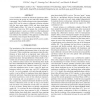Free Online Productivity Tools
i2Speak
i2Symbol
i2OCR
iTex2Img
iWeb2Print
iWeb2Shot
i2Type
iPdf2Split
iPdf2Merge
i2Bopomofo
i2Arabic
i2Style
i2Image
i2PDF
iLatex2Rtf
Sci2ools
ICASSP
2011
IEEE
2011
IEEE
A collaborative filtering approach for quasi-brain-death EEG analysis
A novel method to evaluate the statistical significance differences between the groups of coma and brain death patients is presented. This is achieved based on the electroencephalogram (EEG) and by using a collaborative filtering structure with the least mean square (LMS) and least mean phase (LMP) adaptive filters. By virtue of a complex-valued representation of pair-wise EEG signals, the evolution of the mixing parameter is used as an indicator of the fundamental amplitude-phase relationships of EEG recordings. Simulations illustrate the suitability of this approach to differentiate between the coma and quasi-brain-death states.
Brain Death Patients | ICASSP 2011 | Pair-wise Eeg Signals | Signal Processing | Statistical Significance Differences |
Related Content
| Added | 20 Aug 2011 |
| Updated | 20 Aug 2011 |
| Type | Journal |
| Year | 2011 |
| Where | ICASSP |
| Authors | Yili Xia, Ling Li, Jianting Cao, Martin Golz, Danilo P. Mandic |
Comments (0)

